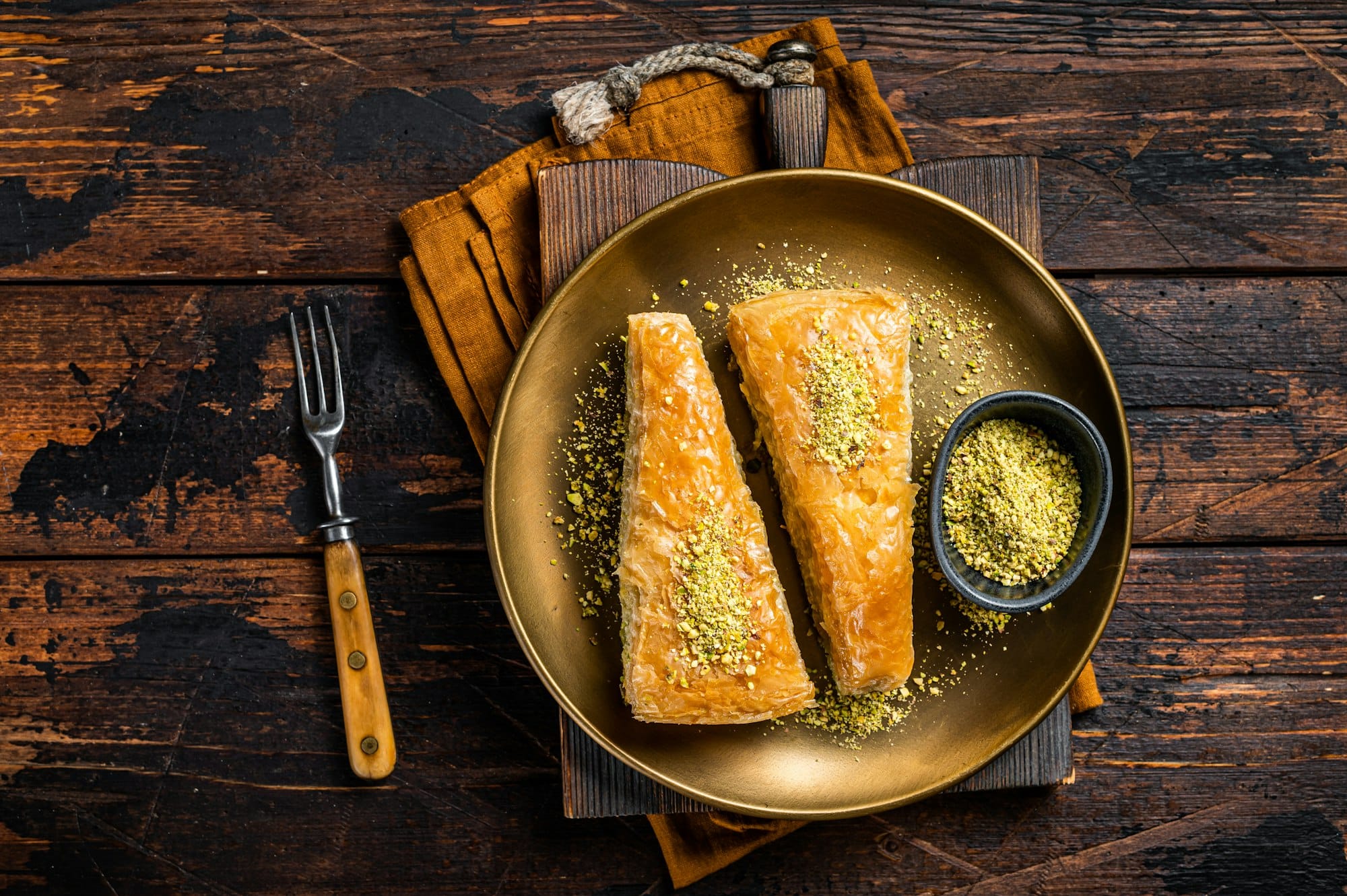What Techniques Will Perfect a Layered Greek Baklava with Honey and Nuts?

Baklava, the word itself rolls off the tongue and fills the mouth with an anticipation of sweetness. Assembled with crumbly nuts nestled in between sheets of thin phyllo pastry, held together by a sticky honey syrup, baklava is a delectable dessert of Greek origin that is enjoyed around the world. This article will delve into the techniques you will need to perfect this layered confection, educating you on the art of baklava making.
Getting Started: The Essentials for Greek Baklava
Before embarking on your baklava-making journey, it’s crucial to be well-acquainted with the essential ingredients and tools. This way, you can ensure a smooth and seamless process and, ultimately, a delicious result.
Lire également : How to Achieve the Ultimate Canadian Poutine with Homemade Gravy?
Baklava’s central components are phyllo dough, butter, nuts, and a honey syrup. Phyllo dough, known for its paper-thin sheets, forms the flaky layers of the pastry. This dough is often brushed with melted butter, which gives the baklava its rich taste and golden color. Nuts, typically walnuts, add crunch and a hearty flavor. Finally, the honey syrup, made from sugar and honey, provides the dessert’s signature sweetness and stickiness.
For optimal results, quality ingredients are essential. Opt for fresh, high-quality nuts and genuine honey for the syrup. As for the phyllo dough, it can be store-bought for convenience. However, making homemade phyllo dough can elevate your baklava to a whole new level of deliciousness.
Lire également : What’s the Key to a Perfectly Balanced Sweet and Spicy Thai Mango Salad?
Preparing the Phyllo Dough: The Art of Layering
Phyllo dough is notoriously delicate and tricky to handle, but with the right techniques, you can master the art of layering. The key to successful baklava lies in the thinness and evenness of the phyllo sheets.
Begin by cutting the phyllo sheets to fit your baking pan. After that, keep the unused sheets covered with a damp cloth to prevent them from drying out. Subsequently, lay down a sheet of phyllo in your prepared pan and brush it generously with melted butter. Repeat this process until you’ve built up several layers – typically around 8 to 10 for the base.
When layering, make sure the butter is evenly distributed over each sheet to ensure every part of the baklava will turn golden and crisp. This meticulous attention to detail will make for a well-structured and delicious pastry.
The Nut Filling: Achieving the Perfect Crunch
The nut filling is what gives baklava its distinctive crunch and heartiness. Traditionally, the recipe calls for walnuts, but you can also experiment with other nuts such as pistachios or almonds.
It’s essential to chop the nuts finely, but not too much, as you still want some texture. Then, mix the chopped nuts with sugar and optionally, some cinnamon for added flavor. The sugar will caramelize during baking, further enhancing the nuttiness of the filling.
After you’ve layered half of your phyllo sheets in the pan, evenly sprinkle the nut mixture over the dough. Then continue with the remaining layers, always remembering to brush each sheet with butter.
The Honey Syrup: Balancing Sweetness and Moisture
The last component – the honey syrup – is arguably the soul of baklava, providing both sweetness and moisture. It’s a simple mixture of water, sugar, and honey, simmered until it thickens.
The crucial part of working with the syrup is the timing. Pour it over the baklava as soon as it comes out of the oven. By doing this, the hot pastry will absorb the syrup more effectively, resulting in a moist and flavorful dessert.
The honey syrup does contribute significant sweetness. However, it’s essential to strike a balance so that the baklava isn’t overly sweet. Adjust the sugar to your liking, but bear in mind that the syrup also needs to be of a certain consistency to be well-absorbed.
Baking and Serving: The Final Steps
After assembling your baklava, it’s time to bake it until it’s beautifully golden and the edges are crisp. This process typically takes about 50 minutes in a preheated oven. Patience is key here, as rushing this step will affect the quality of your baklava.
Once the baklava is done, let it sit for a few hours or, even better, overnight. This resting period allows the syrup to soak in and the flavors to meld together, resulting in a tastier baklava.
When it comes to serving, cut the baklava into small squares or diamonds. This rich pastry is traditionally served with a cup of Greek coffee or tea, making it a perfect treat for any occasion.
The art of baklava making is a process where precision and patience yield a wonderfully satisfying result. With practice, you can master these techniques and enjoy homemade Greek baklava anytime you wish. So why not roll up your sleeves and give it a try?
Adding Flavor: Enhancing Your Baklava With Spices and Lemon Juice
To elevate your Greek baklava recipe, incorporating additional flavors can be a game-changer. Notably, spices and lemon juice are traditional elements that can contribute depth to the flavor profile of your baklava.
Cinnamon is a classic spice used in baklava recipes. Its warm, sweet, and slightly spicy flavor complements the nut mixture beautifully. Adding a dash of cinnamon to your chopped nuts can help accentuate their natural flavor while introducing a delightful complexity. For those who favor a hint of exotic aroma, try adding a sprinkle of ground cardamom. Its sweet, spicy, and floral notes can introduce an intriguing edge to your dessert.
Lemon juice, on the other hand, can be incorporated into your honey syrup. Adding a few drops of fresh lemon juice to the syrup can balance the overall sweetness while adding a touch of tanginess. This subtle sour note can refresh the palate, making each bite of the baklava even more enjoyable.
Remember, moderation is key when adding these flavor enhancers. Too much can overpower the natural flavors of the phyllo pastry, nuts, and honey syrup. Always taste as you go to ensure a harmonious blending of flavors.
Conclusion: Mastering the Art of Greek Baklava
Creating the perfect layered Greek baklava is indeed an art that requires precision, patience, and practice. From preparing the delicate phyllo dough and the hearty nut mixture to crafting the sweet honey syrup, every step contributes to the final masterpiece.
Remember to keep your phyllo sheets at room temperature and to coat them adequately with melted butter. This will ensure a crispy, buttery baklava with a beautiful golden hue. The nut mixture should be finely chopped but still retain some texture to provide the perfect crunch. Keep the honey syrup balanced in sweetness and consistency to maintain the right moisture level in your baklava.
The addition of spices like cinnamon or cardamom and a hint of lemon juice can further enhance the flavor profile of your baklava. While baking, be patient and let your baklava achieve a crisp edge and golden color. Once baked, allow it to rest and soak in the honey syrup overnight for the best flavor infusion.
With these techniques in your arsenal, you can master the art of baking an exquisite Greek baklava. Whether it’s for a festive gathering or a cozy tea time, this delectable dessert is sure to delight your taste buds. Now, it’s time for you to roll up your sleeves, start baking, and enjoy the rewarding process and delicious outcome of making your own baklava!
